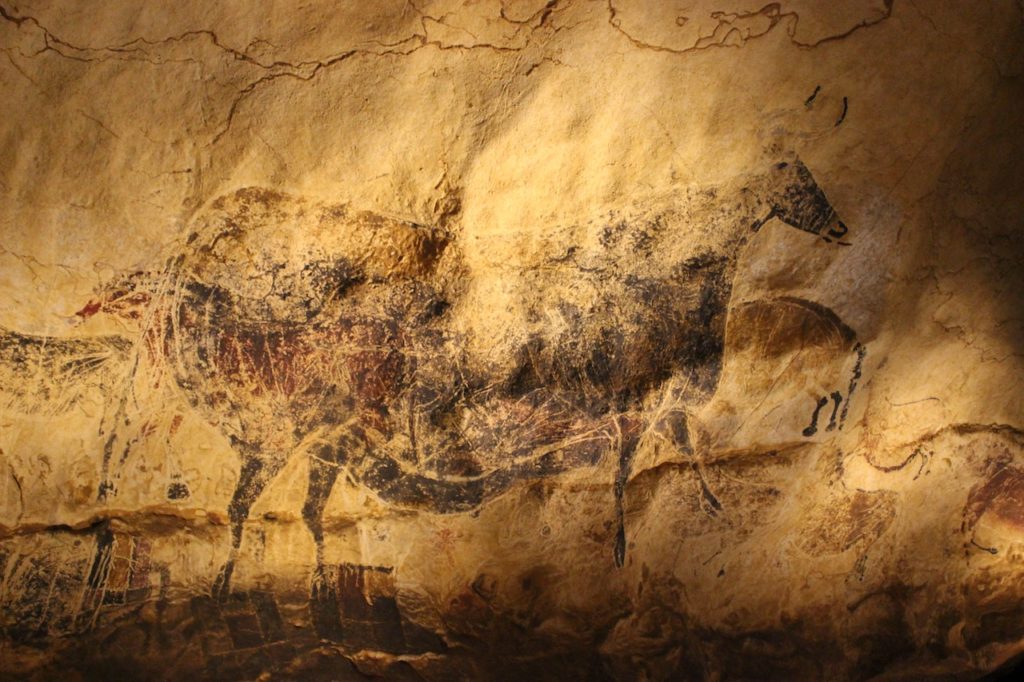
When did cave paintings first appear? The oldest cave painting found so far is from 50,000 years ago but the oldest known prehistoric art was from 73,000 years ago, painted on a rock. There is a lot more cave art to be found than art outside caves because the caves protect the paints and the dyes from the elements. There may have been even older art painted on rocks, but it hasn’t stood the test of time.
There is possibly art that was made 500,000 years ago, but nobody can tell if it is definitely art. A shell was found with a zigzag pattern carved into it. The pattern looks like it was carved rather than natural scratches, and it was possibly carved with a shark tooth. If it was carved by people, then it was probably made by Homo erectus, but why it was carved is anyone’s guess. It could be art. There are other items that have been found that could be art but are pretty controversial. One is the Venus of Tan-Tan, which is between 300 and 500,000 years old. It is a stone in the shape of a human figure and the person who discovered it claims that it has been carved with stone. It has not been independently verified.
The first painting by humans was found in the Blombos Cave in South Africa. Archaeologists found small rock fragments that had been painted with red ochre. The rock was painted with lines in a geometric pattern and the lines break off abruptly, indicating that it was originally a much larger object. It has been dated to 73,000 years ago, making it the oldest human-painted artwork ever found. The archaeologists also found an ochre processing workshop in the same cave that they believe is 100,000 years old. This matches with containers that archaeologists believe held paints, which were found in Africa from about the same era. However, ochre is also an insect repellent, so these items might not have been related to painting.
A geometric shape may or may not be art. It may represent something, or it may have another meaning. The person that made it could have just been absentmindedly drawing lines. There is no way of knowing. The earliest prehistoric art that can actually be called art was found in a cave at Lubang Jeriji Saleh and it has been dated to between 40,000 and 50,000 years ago. It is a painting of a bull painted with red ochre and iron oxide paint. There are other marks painted with fingers in the cave that are about 52,000 years old, but the bull is the oldest painting found. Analysis of the paint showed that the cave was painted in three different phases. In the first phase, the finger marks and the bull were painted. In the second phase, they used a mulberry color and painted human figures and intricate designs. In the third phase, they painted more human figures and geometric designs. It is a fascinating look at the evolution of cave painting.
Cave paintings have been discovered on every continent that had prehistoric people. There may have been more, but they might not have survived. There is also the possibility that some even older paintings are sitting on a cave wall somewhere, just waiting to be found.
So, why are cave paintings so significant? The ability to create abstract art is a sign that humans had evolved a more complex brain. Our ancestors lost their tails about 25 million years ago and started walking upright about 6 million years ago. We stopped living in trees about 4 million years ago and we lost our body hair about 2 million years ago. We first started using tools around about this time. The earliest tools ever discovered came from about 2.6 million years ago. Being able to make tools shows an evolution in intelligence, but it is far short of the intelligence we have today. Many animals can make and use tools. What really sets us apart from the animals is our ability to think and plan for the future.
A gradual change in our brains began around this time. We started to use tools and hunt in groups. This increased the amount of food we could eat, which meant there was more energy for our brains to grow. We also developed the ability to communicate with each other, further increasing our hunting advantage. Along with this, we developed the ability to imagine future events. This was a vital skill when it came to hunting because it meant early humans could virtually test ideas without putting themselves in danger. They were then able to communicate what they imagined. One part of this way of thinking and of language itself was symbolism. Words represent something else and pictures do as well. The early cave paintings are invaluable because they show that humans had developed sophisticated abstract thinking. And this is what I learned today.
Photo by toshihiko tanaka: https://www.pexels.com/photo/a-wall-painting-at-lascaux-cave-13735336/
Sources
https://www.history.com/news/prehistoric-cave-paintings-early-humans
https://en.wikipedia.org/wiki/Cave_painting
https://www.smithsonianmag.com/history/journey-oldest-cave-paintings-world-180957685/
https://en.wikipedia.org/wiki/Prehistoric_art
https://link.springer.com/chapter/10.1007/978-4-431-56582-6_14
https://www.frontiersin.org/articles/10.3389/fnana.2014.00015/full
